
The light brown apple moth is a leafroller moth belonging to the lepidopteran family Tortricidae.
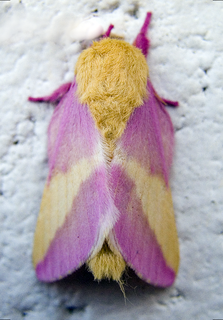
Dryocampa rubicunda, the rosy maple moth, is a small North American moth in the family Saturniidae, also known as the great silk moths. It was first described by Johan Christian Fabricius in 1793. The species is known for its wooly body and pink and yellow coloration, which varies from cream or white to bright pink or yellow. Males have bushier antennae than females, which allow them to sense female pheromones for mating.

The hemlock moth, also known as the defoliating hemlock moth or poison hemlock moth, is a nocturnal moth species of the family Depressariidae. Of Palaearctic origin, it was first found in North America in 1973 when it was accidentally introduced. The moth is now widespread throughout the northern half of the United States, southern Canada, northern Europe, and, more recently, New Zealand and Australia. The larval form grows to around 10 mm, while the adults wingspan is between 17 mm and 19 mm.

Calpodes ethlius, the Brazilian skipper, larger canna leafroller or canna skipper, is a butterfly of the family Hesperiidae. It is found in the United States from southern Florida and southern Texas, south through the West Indies, Mexico, and Central America to Argentina. Strays and temporary colonies can be found north to southern Nevada, northern Texas, Illinois and Massachusetts.
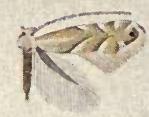
Phyllonorycter ostryaefoliella is a moth of the family Gracillariidae. It is known from Canada and the United States.
Macrosaccus uhlerella is a moth of the family Gracillariidae. It is known from Illinois, Missouri, New York, Colorado and Texas in the United States.

The cherry blotch miner moth is a moth of the family Gracillariidae. It is known from Canada and the United States.
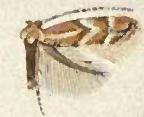
Phyllonorycter celtisella is a moth of the family Gracillariidae. It is known from Ontario in Canada and Connecticut, Illinois, Kentucky, Ohio, Oklahoma, and Texas in the United States.
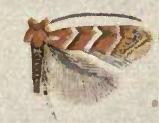
Cameraria caryaefoliella is a moth of the family Gracillariidae. It is known from Ontario and Quebec in Canada, and the United States.

Micrurapteryx salicifoliella is a moth of the family Gracillariidae. It is known from Canada and the United States.
Caloptilia belfragella is a moth of the family Gracillariidae. It is known from Quebec and the United States.

Caloptilia blandella is a moth of the family Gracillariidae. It is known from Canada (Québec) the United States.

Caloptilia negundella, the boxelder leafroller, is a moth of the family Gracillariidae. The species was first described by Vactor Tousey Chambers in 1876. It is known from the Canadian province of Quebec and the US states of Colorado, Kentucky, New York, California, Maine, Ohio and Vermont.
The sassafras caloptilia moth is a moth of the family Gracillariidae. It is known from Canada and the United States.

Caloptilia quercinigrella is a moth of the family Gracillariidae. It is known from Connecticut, Illinois, Florida, Georgia, Maine, Maryland, Michigan and Texas in the United States.

Caloptilia packardella is a moth of the family Gracillariidae. It is known from Quebec, Canada, and the United States.

Lithocolletinae is a subfamily of insects in the moth family Gracillariidae. It is distributed worldwide, with most species in temperate regions.
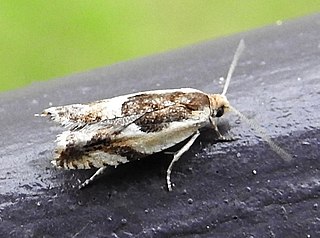
Ancylis discigerana, the birch leaffolder or yellow birch leaffolder moth, is a moth of the family Tortricidae. It is found in north-eastern North America.
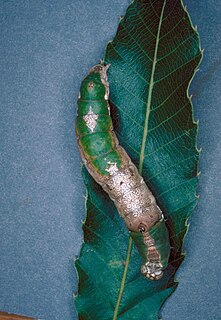
Oligocentria lignicolor, the white-streaked prominent moth or lacecapped caterpillar, is a moth of the family Notodontidae. It is found in North America, including Connecticut, Georgia, Illinois, Louisiana, Massachusetts, Mississippi, Missouri, New Brunswick, New Jersey, New York, North Carolina, Oklahoma and Pennsylvania.

Diploschizia impigritella, the yellow nutsedge moth or the five-barred glyphipterid moth, is a species of sedge moth in the genus Diploschizia. It was described by James Brackenridge Clemens in 1862. It is found in North America, from Newfoundland to Florida, west to Texas and North Dakota. It has also been recorded from California.













